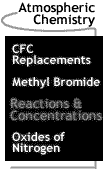

 |
Atmospheric Chemistry: Reactions and
Concentrations Reactions A series of chemical reactions high in the stratosphere result in both the production and destruction of ozone. Ozone is produced when uvc radiation interacts with a diatomic oxygen molecule, resulting in two oxygen atoms: O2 + hu --> O + O. (hu represents uvc radiation.) These oxygen atoms are now free to react with diatomic oxygen molecules, resulting in ozone: O + O2 --> O3. Ozone molecules are destroyed by uvb radiation: O3 + hu --> O2 + O ; O + O3 --> 2O2. Because of the absence of uv radiation, neither production nor destruction of ozone occurs at night as a result of this process.
Sunlight, however, is not the only way ozone can be destroyed. Reactions involving compounds containing nitrogen, hydrogen, chlorine, and bromine can enhance the destruction of this relatively unstable molecule. Concentrations Ozone concentrations in the stratosphere range from 1012 molecules/cm3 (0.5 ppmv) at an altitude of 15 km, to 1013 molecules/cm3 (8 ppmv) at an altitude of 25 km, to 1011 molecules/cm3 (3 ppmv) at 45 km. So whether the concentration is viewed from the aspect of actual molecular density or mixing ratio, the highest concentration is at about 25 km, well into the stratosphere. The chemistry of ozone in the atmosphere depends upon many things, including uv radiation and the presence of other chemical species.
[ Atmospheric Physics ] [ Atmospheric Chemistry: CFC Replacements / [ Home ] [ Teacher Pages ] [ Modules & Activities ] |
HTML code by Chris Kreger
Maintained by ETE Team
Last updated April 28, 2005
Some images © 2004 www.clipart.com
Privacy Statement and Copyright © 1997-2004 by Wheeling Jesuit University/NASA-supported Classroom of the Future. All rights reserved.
Center for Educational Technologies, Circuit Board/Apple graphic logo, and COTF Classroom of the Future logo are registered trademarks of Wheeling Jesuit University.